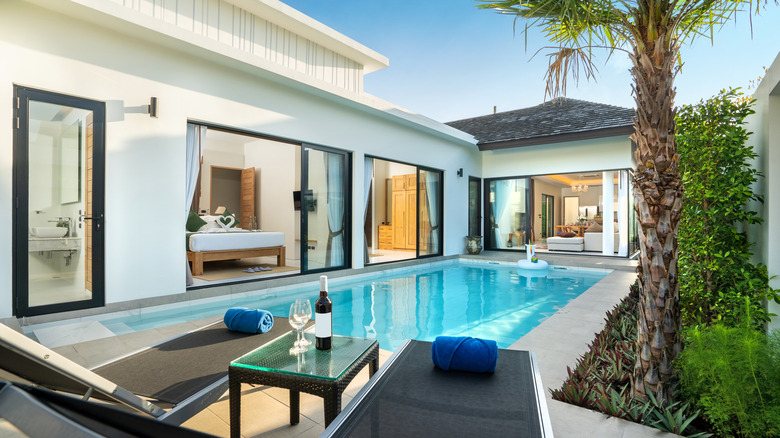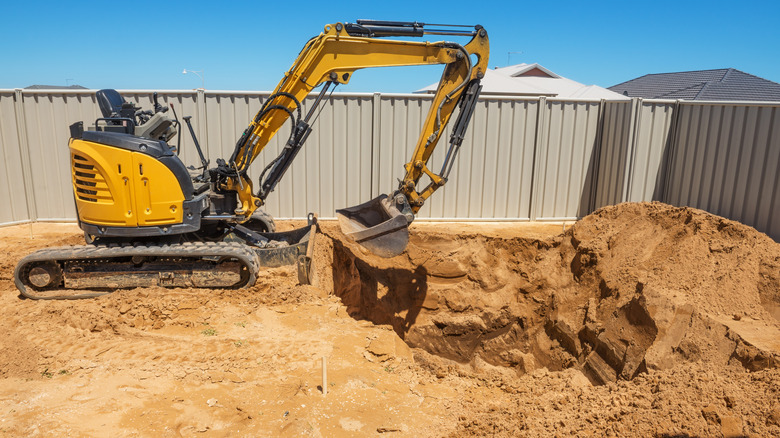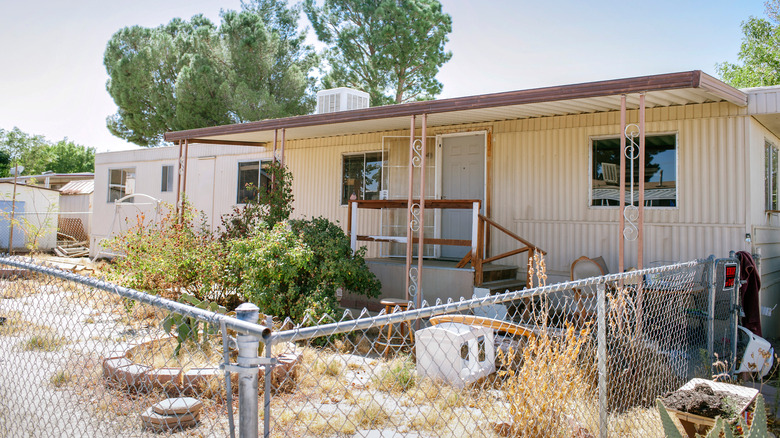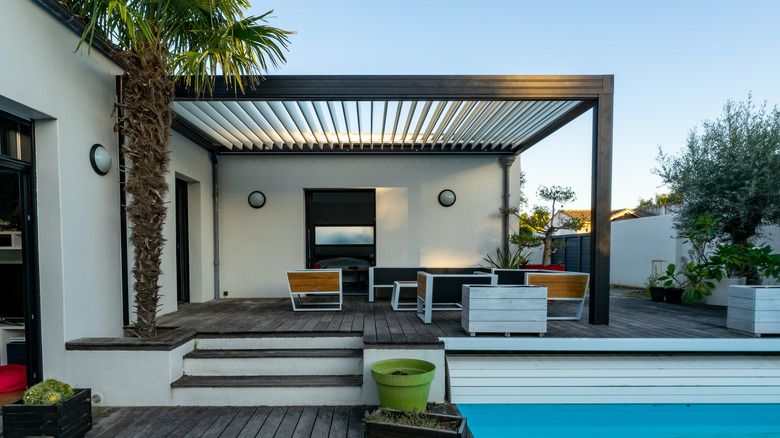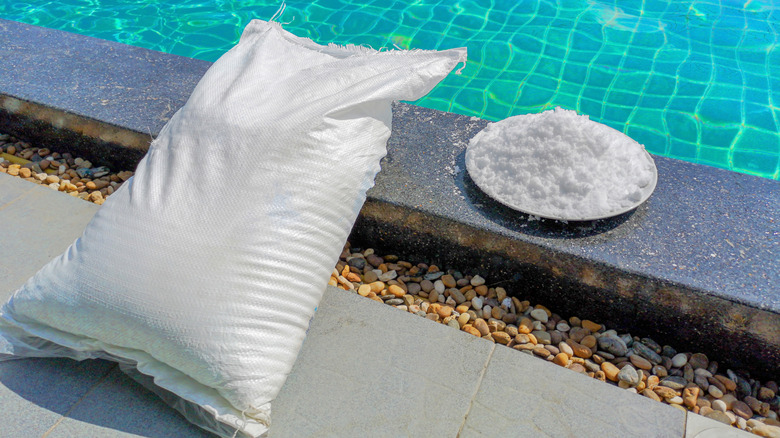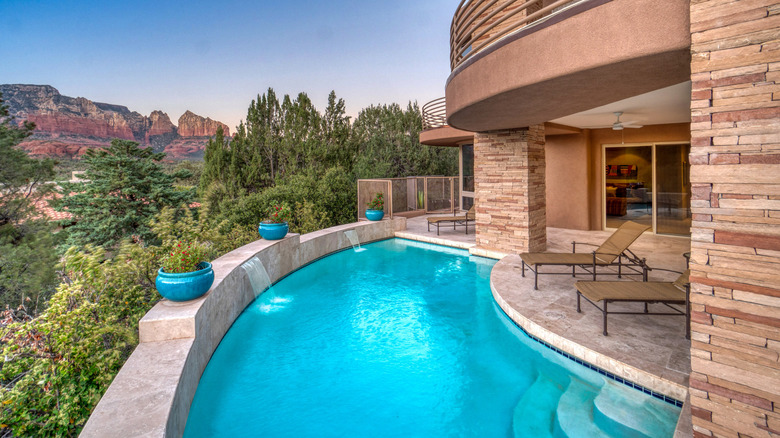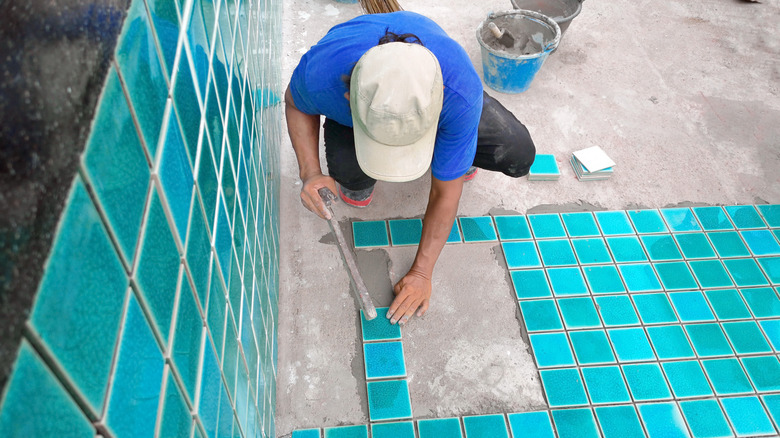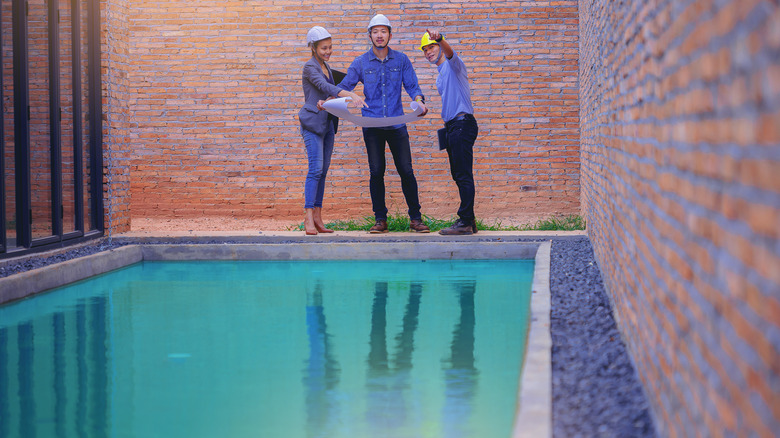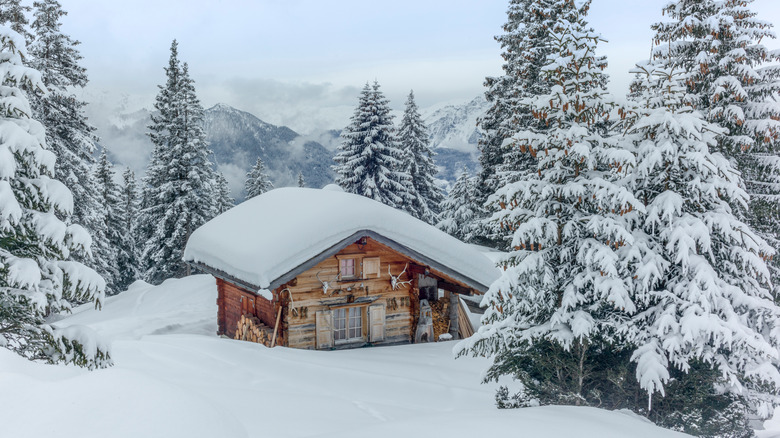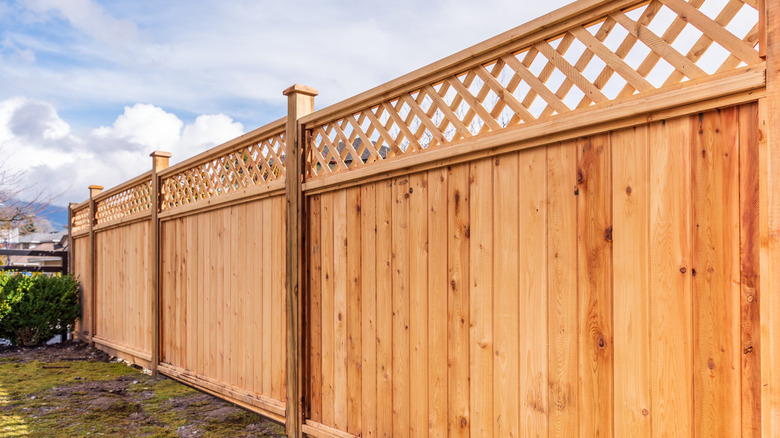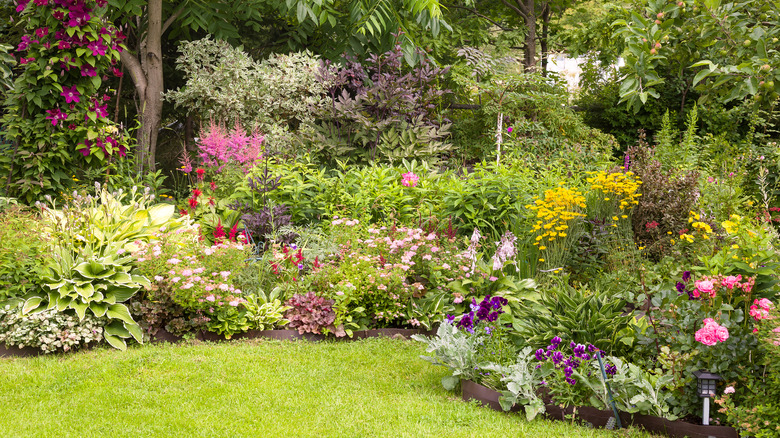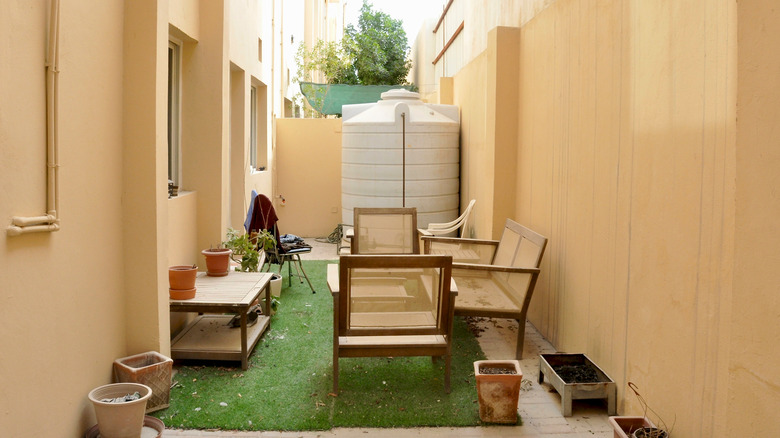Mistakes Everyone Makes When Buying A Pool
There's a lot of excitement when deciding to buy a pool. Understanding the mistakes everyone makes when buying a pool is helpful as you prepare, plan, and avoid potential problems. There are several questions to ask yourself before jumping in. Can you afford a pool? Are you prepared to wait a long time for the completion of it? Is your yard "pool ready," and how will it look once it's in? What type of fence is required for the protection of yourself and others? Will your neighborhood even allow a pool?
For many, a swimming pool in the backyard is a lifelong dream. Hold onto that dream, and don't be afraid to set goals to make it a reality. Just take note of the many things to be aware of as you plan and budget. Once you understand which mistakes to avoid, it's time to set the plan into motion, stock up on sunscreen, and prepare for many summers of making memories while making a splash.
Expecting a quick turnaround
Don't expect to decide on a pool in May and have it up and running by June. Permits and planning take time, so plan accordingly. The actual installation may only take a month or two, however, according to the Pool Buyer Guide, the timeframe from planning to completion is sometimes as long as nine months. That's a little disappointing to those hoping to work on their tan poolside this summer. Why does it take so long?
Well, for starters, pool options are endless. If the plan is to simply call a pool company and ask them to come out, dig a hole and fill it with water, you're out of luck. It takes time to plan where to put the pool, design it with a designer, then wait your turn to have it installed. Like most home improvement projects, you can expect hiccups along the way, which often slows the process. It's best to plan for your pool at least a year ahead of time and understand installation can only begin when the ground isn't frozen.
Forgetting to check with the city and HOA
Ouch -– imagine beginning to dig, only to find a city official or your pesky neighbor knocking on your door to complain. One of the biggest mistakes people make when buying a pool is forgetting to contact the city as well as the homeowner's association (if necessary). A permit is often needed to make changes to a property, and according to Pool Research, many cities aren't shy about penalizing homeowners for skipping the permit. If it's required, make it happen before going any further in the process.
Some areas within a town can't have a pool due to underground pipes or city ordinances. A call to the city answers that concern. Look around your neighborhood. Do you see other pools? Are they above ground or inground? Or is there a mix? Remember, just because your neighbor has an inground pool doesn't mean your yard is allowed to have one as well. Seeing other pools should give you a good idea that it's probably okay. Still, contact whoever needs to be contacted to play it safe, including your HOA, before getting your heart set on a pool.
Assuming the yard can handle an inground pool
Sometimes a yard may have unforeseen drainage problems or other issues underground. According to InTheSwim Pool Blog, sometimes, when digging starts, a high-water table is discovered or other water drainage issues. An above-ground pool may be a better option in these cases unless the proper repairs are made before installing an inground one. Poor drainage leads to a host of problems for your yard and your home.
It's also important to look at the level of the yard. Is it on a hill or very uneven? There aren't a lot of yards that are perfectly flat and ready to maintain a level pool. Thankfully, most yards are repairable if the need arises. Lower areas are built up, and higher ones leveled off. Even the rockiest of terrains become smooth with the right equipment and removal of rocks. Your pool contractor is your best bet in finding out if your yard can handle a swimming pool, and if not, how to fix it.
Trying to cut costs
According to HGTV, the average cost for an inground pool from start to finish ranges from $30,000 to $60,000. That's a lot of money, but the range gets much higher when homeowners consider adding waterfalls and other elaborate designs. It's understandable to want to save money. Still, a new pool is an investment, and when done properly, it brings years of use and joy. Have a well-thought-out plan and a realistic budget before diving in to have the pool of your dreams.
A few ways homeowners try to save money during pool design and installation is by choosing to do tile, cement, or brickwork themselves, excavating the area themselves, or choosing the cheapest materials rather than what a pool designer recommends. Pool design and installation are expensive. It's something that must be planned and budgeted for. Trying to cut corners isn't wise when it comes to such a large home improvement project that requires certain safety measures and a beautiful finish for the enjoyment of the homeowner.
Placing a pool in the shade
No one wants to swim in the shade. Your yard may be large enough to handle a pool, but is it shade-covered? The shade is wonderful and the trees that offer it to us are beautiful. Still, if parting with trees or trimming them back breaks your heart, then a pool may not be the best option for you.
The great news is, it's possible to have both, especially if you haven't chosen any trees yet or you can easily replace what you already have. The secret is choosing the right tree for the job. When selecting trees to place near a swimming pool, The Spruce recommends considering the roots of the tree, so they don't cause pool destruction, as well as the amount of potential leaf droppings into or near the pool. Also, think ahead to what the tree may block at full maturity. Is there a view you enjoy while sipping mimosas on your floaty? If so, don't plant a tree that will someday block your view and disrupt Saturday morning drinks. Consider planting trees that do just fine in large containers that are easily moved if necessary. And of course, if you must have trees, choose ones that flow with the rest of your pool décor.
Not understanding the difference between salt and chlorine
Today, there are two choices for maintaining a clean and healthy pool: saltwater or chlorine. Unfortunately, one of the mistakes people make when buying a pool is choosing what they know and are comfortable with rather than researching both options. Before choosing a pool, understand the differences between saltwater and chlorine pools.
According to HomeAdvisor, there are pros and cons to both options. While chlorine pools are less expensive to get started, saltwater pools require less maintenance in the long run. Pick your battles. You may feel you're saving money upfront with chlorine, but in the end spend more on maintaining your chlorinated pool. On the other hand, if the budget is tight for installation, saltwater may not be what's best for now. Discuss both options with your swimming pool designer. Things like climate and lifestyle are important to consider when choosing which method is best for your backyard swimming pool.
Is the pool aesthetically pleasing?
A pool takes up a lot of space, and it's absolutely the focal point in a backyard. Not considering this when designing one is a big mistake. Imagine digging up most of the yard, completing the installation, then looking out the back window only to find an eyesore. Allow a designer to help you envision your future swimming pool. Many designers use computer programs to help homeowners see clearly how the pool will look when completed. It's not just a hole in the ground you're investing in. A pool becomes a large part of the landscape. Make yours a work of art, or keep it simple. That's up to you.
The possibilities are endless to make your new pool aesthetically pleasing. Rocks, waterfalls, and different pool shapes are easy options. According to House Beautiful, pools can have a multitude of designs, from Tuscan-style to rustic farmhouse. Get creative and make your pool a part of your home. It sets the mood just as every other area of the house does.
Choosing the wrong materials
Homeowners have options when it comes to materials used for designing and building the pool of their dreams. Discuss the different types of materials with your designer to choose what's best for your family. According to The Spruce, there are four main options for inground pool materials: concrete, fiberglass, vinyl, and alternative materials. As with most things, they each have their pros and cons.
Vinyl is inexpensive, but it deteriorates the quickest, thanks to UV and chemical exposure. Concrete is the original material used for inground pools and remains highly popular. It's very durable and easily repaired. Fiberglass is great if you want a pool quickly or quicker than some other options. They are delivered to your home, ready-made in whichever shape and size you order. For this reason, however, they're difficult to customize. Alternative materials include plaster, colored concrete, and stone. Your pool designer will ask the right questions to help you choose the right material. Longevity, maintenance, and cost are three important factors to consider.
You don't click with your contractor
Installing a pool is a long process from design to installation. Don't simply choose the first contractor that pops up. It's okay and wise to interview a few until you find the one you click with. It'll make the whole process more enjoyable. The Better Business Bureau recommends talking with friends and family who've recently gone through a pool installation. Doing so helps alleviate extra homework for you since they can tell you who to trust or who not to trust. They can also let you know why they'd never install a pool without the help of a contractor.
A good contractor holds your hand from design to completion. Whomever you choose to work with becomes a part of your life during the entire process. If you think of it that way, it's easy to understand why you need to not only like but also trust your contractor. If a contractor is offended that you're interviewing a few before deciding, they aren't the one for you. Scratch them off the list and move on.
Dreaming of Florida but the home is in the Northwoods
No one can steal your dreams. Dream away and build that pool you've always wanted ... just remain realistic. Consider the cost of a pool with the reality of the climate you live in. A swimming pool is enjoyed nearly all year long in some areas, justifying the cost. In other areas, homeowners are lucky to get two to three months of pool use. Keep in mind that the maintenance of a pool goes beyond the summer months when it's used. That doesn't mean you shouldn't have a pool, but it's something to consider seriously. It's easy to think you need a pool on a rare, 90-degree day in July, but you might second guess your decision once the chilly autumn air blows in.
If you choose to go for it, colder climate or not, River Pools suggests that a fiberglass pool may be your best bet. Fiberglass is flexible, making it less prone to cracking under freezing temperatures than concrete and vinyl.
The fence is an added expense
The installation of a pool means the installation of a fence. Most cities, as well as insurance companies, require a fence once a pool goes in. Already have a fence? Make sure it meets the requirements, such as a specific height for pool safety in your area. According to the Expert Home Report, even if your city or neighborhood doesn't require a fence around the pool, you should get one anyway, for safety's sake. There's even a good chance it'll lower your homeowner's insurance rate.
When designing your pool, choose a fence to go along with it. It would be best if you had a fence that looks as beautiful as your pool and home, a style that doesn't bother your neighbors, and a fence designed to protect children and animals from wandering into a dangerous area. As a bonus, a fence can give you privacy while you pretend you're an Olympic swimmer.
No plan for landscaping
One of the mistakes people make when buying a pool is forgetting to plan for landscaping. Landscaping needs usually change when a pool goes in. When done right, it makes the pool area beautiful. When ignored, you're left with a pool full of water and nothing nice to look at. According to Homes & Gardens, homeowners should think about how to make landscaping work best for their pool and their yard, as they enjoy time outside in the summer. Then, in the winter, take on landscaping projects while everything is dormant. It's a great time to plan.
Everyone's swimming pool journey is different. For some, their backyard is covered in foliage and all things that bloom, and it's tough to know what to save when the pool goes in. For others, their yard is a blank slate, making landscaping possibilities endless after pool installation. Either way, create a design that allows the entire yard to flow together. The swimming pool and landscaping become one, and each should enhance the other.
Not considering the loss of a yard
It seems obvious, but in the excitement of pool planning, it's easy to forget that the pool may completely take over your yard. That's not a problem if all you want is a pool. However, if you're used to some backyard volleyball now and then, plan the pool size accordingly.
Every family has a different idea of what a pool should be, including the size. The first thing to consider is why you want a pool — recreation, sport, exercise? According to Barrier Reef Fiberglass Pools, how you intend to use a pool helps determine the size. For example, if it's simply for family fun, it needs a shallow end for little ones. For exercise enthusiasts, a rectangular shape with deep enough water is essential.
Remain realistic and compare your needs and wants with the size of your yard space. You may want a pool that accommodates toddlers as well as kids on the swim team, but the reality may be that your yard can only accommodate one or the other. If having quite a bit of yard space left is important to you, then don't go too big with the pool.
After installation comes pool maintenance
As the installers get your pool ready for an incredible summer, you dream of the day it's finally done. When the daydreaming stops, remember to make pool maintenance a part of the plan and budget so you have a beautiful pool for many summers to come. A clean pool is, of course, inviting and attractive, beckoning users to stay and play all summer long. Not only that, but according to Lowes, a clean pool that's properly maintained helps keep the drains clear and working efficiently. In the long run, proper maintenance saves you money due to fewer repairs.
If you plan for it, maintenance isn't too difficult. Consider a pool service if you don't think you can maintain the pool independently. Maintenance is essential to get more years and use out of the pool. It consists of not only cleaning the pool and ridding it of debris and algae, but also fixing leaks, adding necessary chemicals or salt, and maintaining the proper temperature. If you think you'll skip a step here and there, don't hire yourself -– hire a professional. Make maintenance a top priority and enjoy your own private swimming pool summer after summer.
